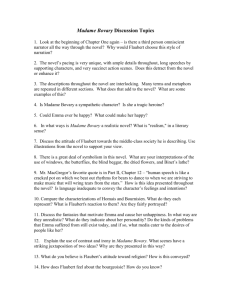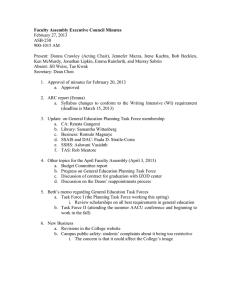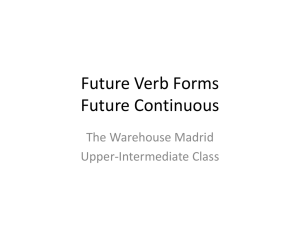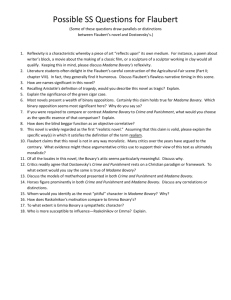21L.472 Major European Novels MIT OpenCourseWare Fall 2008 rms of Use, visit:
advertisement
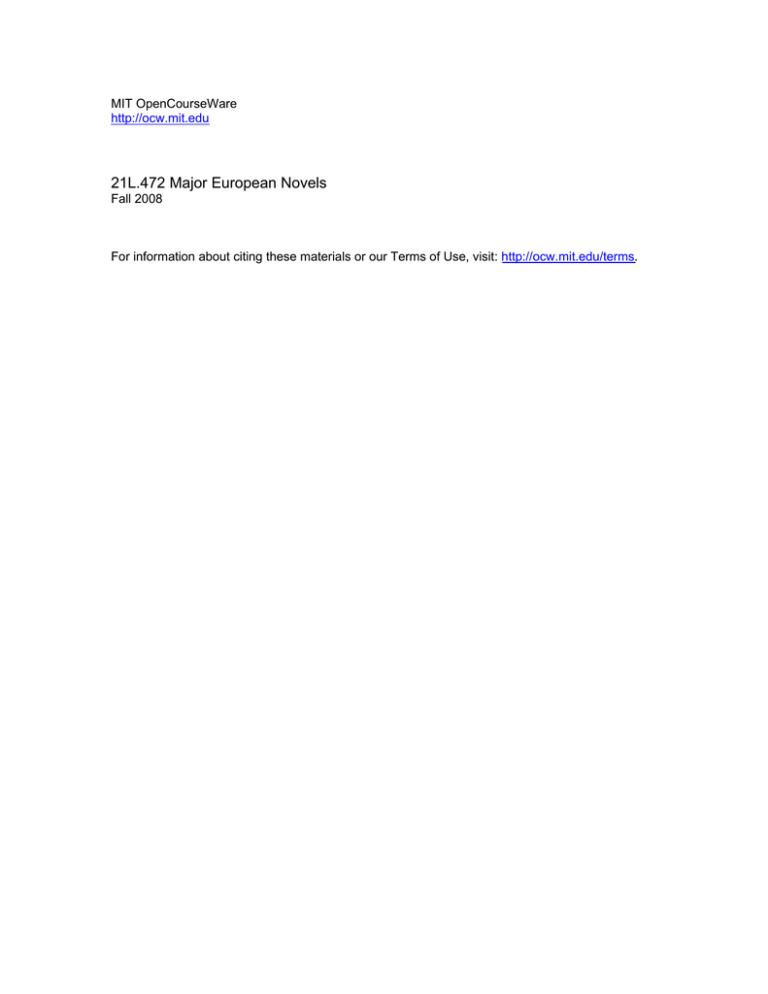
MIT OpenCourseWare http://ocw.mit.edu 21L.472 Major European Novels Fall 2008 For information about citing these materials or our Terms of Use, visit: http://ocw.mit.edu/terms. 21L472 Professor Kibel MAJOR EUROPEAN NOVELS Reading Study and Discussion Questions Flaubert, Madame Bovary Introductory note: Flaubert's novel is the first to make extensive use of "the indirect free style". Le style indirect libre is a piece of French imported into literary criticism; the English indirect free style is also used, but less often. Like most features of utterance that seem perfectly natural, its function is not easy to describe. The oppositions involved are: a. free quotation, in which the words of the speaker are quoted but the speaker is not identified, as opposed to tagged quotation, which designates the speaker; for example, the phrase "You are to go home now", with its quotation marks, versus the phrase I said "You are to go home now", in which the quotation marks are within the phrase, which not only quote verbatim but also identifies the speaker. b. direct quotation, which encloses the actual words of the speaker in quotation marks, as opposed to indirect quotation which may or may not tag the source but which gives the thought rather than the actual words of the speaker. Thus I said, "You are to go home now" versus I told them that they were to go home immediately. Note the two-fold change in tense in the last example-the change in tense (from are to were), and also the change from now to immediately. Both of these changes refer to what linguists call deixis. This term designates elements in an utterance that refer to the time and place of the utterance as opposed to elements in the utterance that refer to the time and place of the events that the utterance is about. In the first phrase, the saying occurred in the past and so the verb indicating speech must be in the past tense; the deictic indicator in what is spoken in direct quotation, i.e. the now, points to the time of the quoted speech of which it is a part. In the second phrase the word now would also refer to the time of utterance, but here the time of utterance is not past; what is spoken of is in the past but the time of utterance is the present and so now is out of place and must yield to immediately. I told them that they are to go home now is not grammatical. The point about the free indirect style is that violates the rule of grammar appropriate to reporting past utterance and does so in a way that we find so natural that it surprises us to learn that it does not appear in print as a regular feature of narrative texts-indeed, it has been argued that it does not appear at all-until the end of the eighteenth century. The device is exclusively literary, that is to say, a feature of fiction. It occurs neither in first-person narrative, whether fictive or true, nor in historical accounts of the past. To illustrate: suppose that a young in an overworked or depressed state of mind has fled the city for the countryside and sits down to write his beloved a letter about the effect of the scenery on his state of mind. In the examples, the elements in italics are deictics, referring to something contemporary with the moment of utterance or in proximity to the spatial position of the writer. Compare: a. Straightforward utterance: "By the time that you receive this, I will be downhearted once more, but for now I am delighted to be here. How beautiful it is!" The exclamation point expresses an emotion contemporary with the time of utterance. b. Indirect utterance: "I believed that by the time you received the letter, I would be downhearted once more, but at the moment I was nonetheless delighted to be there. I thought the scenery was extremely beautiful."The tenses have changed, the "this" and "now" have been replaced by explicit designations. The phrasing of the exclamation has been altered, and exclamation point has vanished; the upsurge of emotion is a sentiment belonging to the past that is described, not to the time of utterance. In the exchange the upsurge has been lost; one can think that something is extremely beautiful and yet have no emotional response whatever. c. Indirect free style: "He sat down to write a letter. By the time that she would receive it, he would be downhearted once more, but his present feelings were unaffected by this thought. How beautiful it was!" The exclamation is not quoted; it is not tagged. The sentence belong to the narrative voice; the young man would not say How beautiful it was but rather How beautiful it is. And yet the reader knows that it registers a sense of things that belongs to the person written about, not to the narrative voice. The words belong to one, the response to the other. Flaubert, Madame Bovary 1 21L472 Professor Kibel MAJOR EUROPEAN NOVELS Reading Study and Discussion Questions Although there is no play with exclamation points, there are some instances of the indirect free style in Balzac and many more in Stendhal. It is a major element in Flaubert. The indirect free style, so to speak, seals the bond between the narrative voice of the text and the character that is chosen as a source of information without identifying them, as first-person narration would do. One can easily see that it has no place whatsoever in Don Quixote. 1. Find examples of the free indirect style: most involve Emma but some involve other characters, particularly Rodolphe. How clear is the distinction between the sentiments or the perceptions, which belong to the characters, and choice of phrases, which belong to the narrative? What is implied about the characters by the ability to make this distinction? 2. In his letters, Flaubert described Madame Bovary as "a book about nothing". He described his prose as trying to fulfill the ambition to be "as transparent as a plane of glass". He argued that art should be "pure"- unalloyed by ethical judgment-and he wrote of his wish to ally art with science rather than with moral judgment. Elaborate on these three notions. What do they mean? Are they connected in some way? Does the novel exhibit them? 3. We are told at one point in the text that Emma, virtually throughout her years of maturity, has been "waiting for something to happen". Yet much happens-she falls in love, she marries, she has a child, she falls in love again, then again, and this time has an adulterous affair, she nearly commits suicide, and so on. What does it mean to say that she is "waiting for something to happen." It is generally the initial response of readers that nothing seems to happen in the book (until the end). Does this put them on a level with Emma, so far as their understanding of events in the book is concerned? 4. We have discussed the notion that characters in a text are defined in some manner relative to the world that the text presents and to the problems that circumstances within this world may pose for characters within it. In this connection, we asked whether certain characters were superior, equal or inferior to other characters in the text or (more importantly) to the implied reader of the text in respect of certain qualities. Discuss any aspect of the issue of ranking characters with respect to qualities by centering discussion on any four of the characters in Madame Bovary. 5. Emma has been described as a trivial person-the equivalent of a housewife in the hinterlands of rural America who stuffs her imagination with television dramas and runs away to the big city to realize her fantasies about love and romance. Is this account adequate to her presence in the novel? Again, Emma has been described as "a female Don Quixote". How just is this comparison? 6. At one point the novel says that Emma "was incapable of . . . recognizing anything that wasn't expressed in conventional terms" (p. 51.) and of Rodolphe, much later in the novel (p. 224) that he can't recognize the uniqueness or genuineness of feeling that might underlie conventional similarities of expression. Does this make them alike or different? 7. Almost all of the characters in Madame Bovary think and feel in conventional ways. The text is suffused with conventionalities of various sorts--conventionalities of religion (the Abbé Bournisien), of science (Homais), of politics (the speaker at the county fair), of art and literature (Emma, Léon, Rodolphe). In an important sense, even Emma's notion of unconventionality is a conventional notion; and the idea of conventionality needs some exploring to resolve this paradox. 8. By use of le style indirect libre Flaubert contrasts the viewpoints of two characters from time to time in the novel. Explore the contrasting viewpoints upon an episode in the book of Charles and Emma, of Rodolphe and Emma, of Lestibudois and Justin, of the Abbé Bournisien and Emma. 9. The test is full of images of realized ambition-images of the sort of realization that Emma never experiences. And these images are all images of grotesque hodge-podges: among them, Charles's school-cap, Emma's wedding cake, the cathedral steeple at Rouen, the festival platter at Vaubeyessard, Flaubert, Madame Bovary 2 21L472 Professor Kibel MAJOR EUROPEAN NOVELS Reading Study and Discussion Questions the cast made for the cripple's leg, the tombstone Charles plans for Emma. What is the point of them in the book? 10. Emma in her affair with Rodolphe is controlled by him; he is the dominant figure, to the point where "he made her into something compliant, something corrupt. (p. 224.) Leon in his affair with Emma is controlled by her; she is the dominant and rather frightening figure. Are these relations transitive? that is to ask, is Emma placed between the two men in point of strength of character? 11. Near the end of the book, a character is briefly introduced- Dr. Larivière-who seems quite different from all the others and he is immediately withdrawn from the action. What was Flaubert's purpose in introducing him? Flaubert, Madame Bovary 3

